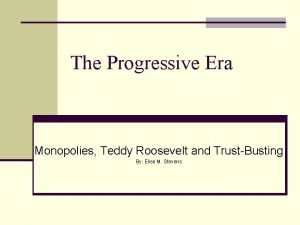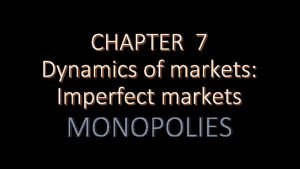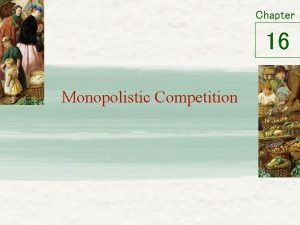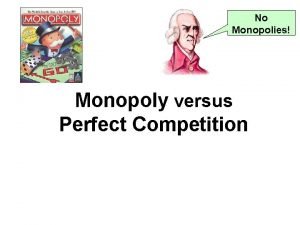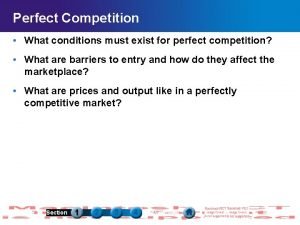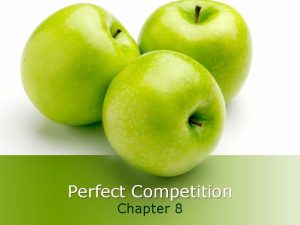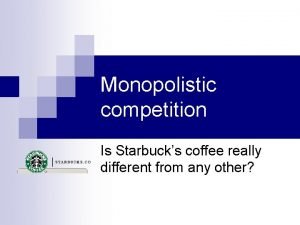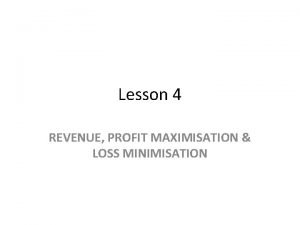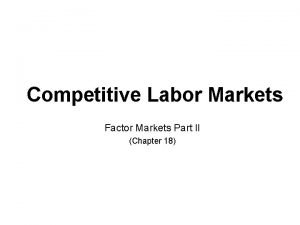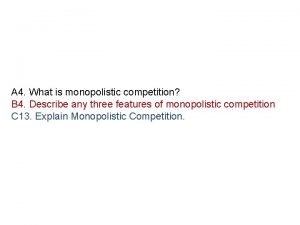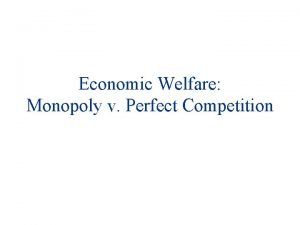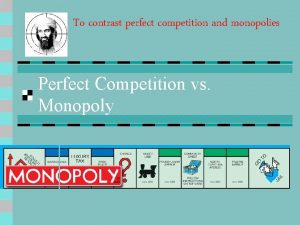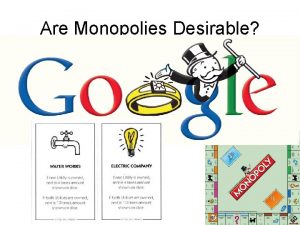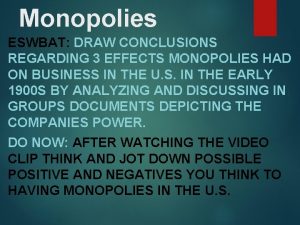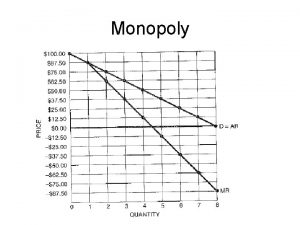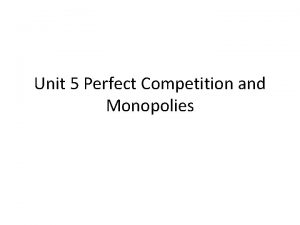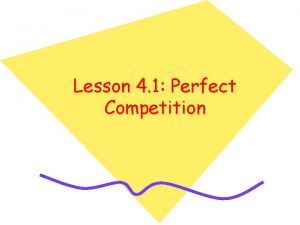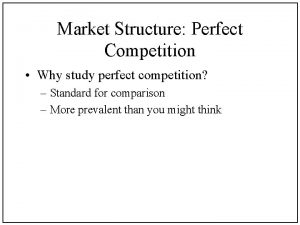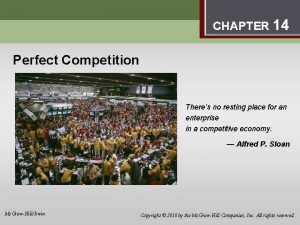COMPETITION AND MONOPOLIES Perfect Competition Competition happens when






































- Slides: 38

COMPETITION AND MONOPOLIES

Perfect Competition � � Competition happens when two or more companies strive against each other to convince consumers to buy their products or services This benefits consumers in two ways � Provides us with choices � Drives down prices

Market Structure and Perfect Competition � � Market Structure: The extent to which competition prevails in particular markets Perfect Competition: Market situation in which there are numerous buyers and sellers, and no single buyer or seller can affect price.

Conditions for Perfect Competition � � � Large Market: Numerous buyers and sellers must exist for the product Nearly Identical Product: The goods or services being sold must be nearly the same Easy Entry and Exit: Sellers already in the market cannot prevent competition, or entrance into the market. In addition, the initial costs of investment are small, and the good or service is easy to learn to produce Easily Obtainable Information: Information about prices, quality, and sources of supply is easy for both buyers and sellers to obtain Independence: The possibility of sellers or buyers working together to control the price is almost nonexistent.

No Control Over Price � � When there is perfect competition, the producers have no control over price because attempting to raise the price would cause consumers to buy elsewhere. Perfect Competition=Market Equilibrium

Monopoly � � A market situation in which a single supplier makes up an entire industry for a good or service with no close substitutes Characteristics �A single seller � No substitutes � Barriers to entry � Almost complete control of market price

Types of Monopolies � Natural Monopolies � Government grants exclusive rights to companies that provide things like utilities. Economies of Scale: Low production costs resulting from large size of output � Geographic Monopoly � Business � Technological Monopoly �A � exists in an area with little competition new invention that is protected by patent or copyright Government Monopoly � Government exclusively produces good or service. Example: Roads, bridges, fire departments, ect.

Oligopoly � Industry dominated by few suppliers who exercise some control over price. � Examples: � Airlines, vehicles, cereal Engage in product differentiation � Nonprice competition Is price the only thing you consider when buying a car? � Interdependent Behavior

Monopolistic Competition � � Market situation in which a large number of sellers offer similar but slightly different products and in which each has some control over price Characteristics � Numerous sellers � Relatively easy entry � Differentiated products � Some control over price

Monopsonies

Monopsonies � Monopsony: Market structure in which one buyer faces many sellers. � Usually occurs in labor markets when there is one company paying for all the labor in one area or when there is only one employer for that specific skill set � Examples: company towns, sweat-shops, wal-mart, school districts, single payer health care systems � Workers face the decision of working for that company or not working at all � Who has all the power in this relationship?

Dangers of Competition � � When competition is especially excessive and concentrated on financial concerns above all else it can cause problems. Race to the Bottom: A situation in which companies attempt to lower costs by offering lower wages or poorer working conditions � Governments also fall into this trap when they compete with one another to offer lower taxes or lower environmental regulations. � The Prisoner’s Dilemma: a situation in which two players each have two options whose outcome depends crucially on the simultaneous choice made by the other

Business Organizations � � � Entrepreneur: Person who organizes, manages, and assumes the risks of a business in order to gain profits Starting any business involves risk “You have to spend money to make money”

Help from the Government � � The Small Business Administration often helps finance startups Small-business incubator: Private or government funded agency that assists new businesses by providing advice or low-rent buildings and supplies.

Types of Businesses Sole Proprietorships � Partnerships � Corporations �

Sole Proprietorship � � Business owned and operated by one person Proprietor: Owner of a business Unlimited Liability: Requirement that an owner is personally and fully responsible for all losses and debts of a business. Personal assets, or items of value such as houses, cars, ect. May be seized to pay off business debts.

Partnerships � � � Business that two or more individuals own and operate. Increases borrowing potential Limited Partnership: Special form of partnership in which one or more partners have limited liability but no voice in management Limited Liability Company: Type of business enterprise that protects members against losing all of their personal wealth; members are taxed as if they were in a partnership Joint Venture: Partnership set up for a specific purpose for a short period of time

Corporations � Business organization owned by many people but treated by law as though it were a person; it can own property, pay taxes, make contracts, and make anonymous political donations!

Corporations � � � Stock: Share of ownership in a corporation that entitles the buyer to a certain part of the future profits and assets of the corporation Limited Liability: Requirement in which an owner’s responsibility for a company’s debts is limited to the size of the owner’s investment in the firm. Common Stock: Shares of ownership in a corporation that give stockholders voting rights and a portion of future profits. Dividend: Portion of a corporation’s profits paid to its stockholders Preferred Stock: Shares of ownership in a corporation that give stockholders a portion of future profits (before profits go to common stock, no voting rights)

The Labor Force � � Civilian labor force: Total number of people 16 years old and up who are either employed or actively seeking work Blue-collar workers: Workers who provide manual labor White-collar workers: Workers employed in offices or sales Service workers: People who provide services directly to individuals

Categorizing by Skill Level � � � Unskilled workers: People whose jobs require no specialized training. Skilled workers: People who have learned a trade or craft either through vocational school or as an apprentice to an experienced worker Professionals: Highly educated individuals with college degrees and usually additional education or training

Type of Worker?

Type of Worker?

Type of Worker?

Labor Unions � � Association of workers organized to improve wages and working conditions for its members Craft Union: Made up of skilled workers in a specific industry Industrial Union: Made up of all workers in an industry regardless of job or skill level Local union: Members of a union in a particular factory, company, or geographic area

How Unions are organized � � Closed shop: Company in which only union members could be hired Union shop: Company that requires new employees to join a union after a specific period of time Agency shop: Company in which employees are not required to join the union but must pay union dues. Right-to-work laws: State laws forbidding unions from forcing workers to join and pay union dues. Why might these be controversial?

Collective Bargaining � � Process by which unions and employers negotiate the conditions of employment Cost-of-living-adjustment: provision calling for a wage increase each year if the general level of prices rises. Mediation: A neutral person tries to get both sides to reach an agreement during negotiations Arbitration: Union and management submit the issues they cannot agree on to a third party for a final decision


Strikes � � Deliberate work stoppage by workers to force employers to give into their demands Picketing: Action of strikers who walk in front of a workplace carrying signs that state their disagreement with the company. Why is this a useful tactic? Boycott: Economic pressure exerted by unions urging the public not to purchase the goods or services produced by a company. Lockout: Situation that occurs when management prevents workers from returning to work until they have agreed upon a new contract

Externalities � � Costs or benefits from an economic transaction that third parties “external” to the transaction receive or incur Externalities can be either positive or negative, and they can be generated from both the production and the consumption side of a transaction

Types of Externalities � � Positive Consumption Externality: An external benefit generated from consuming a good or service. An example could be the reduction in flu that results when some people receive a flu vaccine. � � Negative Consumption Externality: An external consequence generated from consuming a good or service. An example could be the secondhand smoke that results when people smoke cigarettes in public.

Types of Externalities � � Negative Production Externality: An external consequence generated from producing a good or service. Example: pollution or depletion of natural resources. Fish and forests are examples of a “common property” resource, and the depletion of these resources is sometimes referred to as the “tragedy of the commons. ” � � Positive Production Externality: An external benefit generated from producing a good or service. Example: A public park is built near your house, which raises its property value

Positive or Negative?

Positive or Negative?

Positive or Negative?

Positive or Negative?

Positive or Negative?

Positive or Negative?
 Progressive era monopolies
Progressive era monopolies Lump sum subsidy
Lump sum subsidy Perfect competition vs monopolistic competition
Perfect competition vs monopolistic competition Competition refers to
Competition refers to Cortar present perfect
Cortar present perfect Monopoly vs oligopoly venn diagram
Monopoly vs oligopoly venn diagram Long run supply curve
Long run supply curve Difference between perfect competition and monopoly market
Difference between perfect competition and monopoly market Pricing and output decisions in perfect competition
Pricing and output decisions in perfect competition Difference between monopolistic and perfect competition
Difference between monopolistic and perfect competition Difference between short run and long run economics
Difference between short run and long run economics Difference between perfect competition and monopoly market
Difference between perfect competition and monopoly market P=mc
P=mc Difference between perfect competition and monopoly
Difference between perfect competition and monopoly Perfect competition side by side graphs
Perfect competition side by side graphs What is short run equilibrium
What is short run equilibrium Economics shutdown point
Economics shutdown point Monopoly conditions
Monopoly conditions Long run market supply curve
Long run market supply curve Advantages of perfect competition
Advantages of perfect competition Many sellers many buyers
Many sellers many buyers Shut down point in perfect competition
Shut down point in perfect competition Monopolistic competition starbucks
Monopolistic competition starbucks How are market failures different from perfect competition
How are market failures different from perfect competition Barriers to entry for perfect competition
Barriers to entry for perfect competition Profit maximization
Profit maximization Factor market perfect competition
Factor market perfect competition Hello
Hello Perfect competion examples
Perfect competion examples Price determination under perfect competition
Price determination under perfect competition Advantages of monopoly
Advantages of monopoly Supernormal profit in perfect competition
Supernormal profit in perfect competition Graphing perfect competition
Graphing perfect competition Pure competition market
Pure competition market Consumer surplus in perfect competition
Consumer surplus in perfect competition Supernormal profit in perfect competition
Supernormal profit in perfect competition Perfect competition poster
Perfect competition poster Perfect competition quiz
Perfect competition quiz Welfare loss monopoly
Welfare loss monopoly
